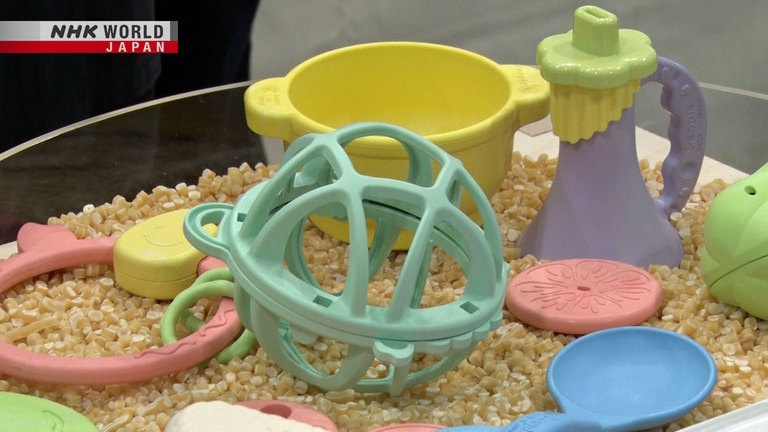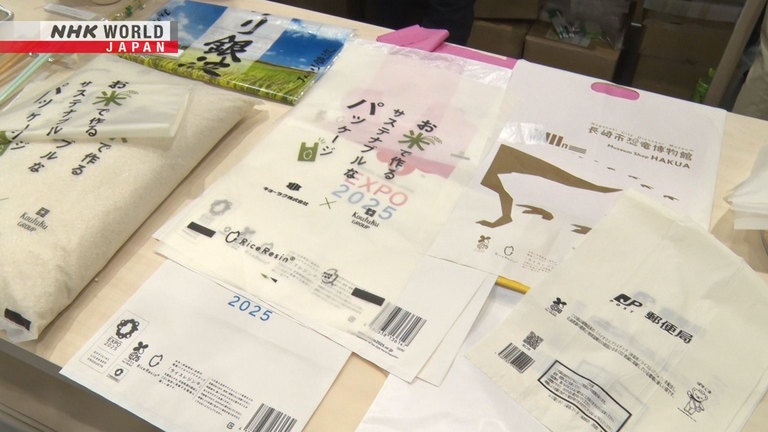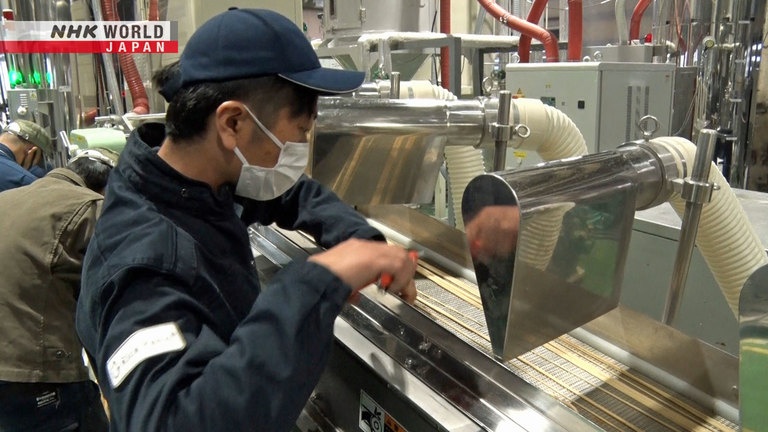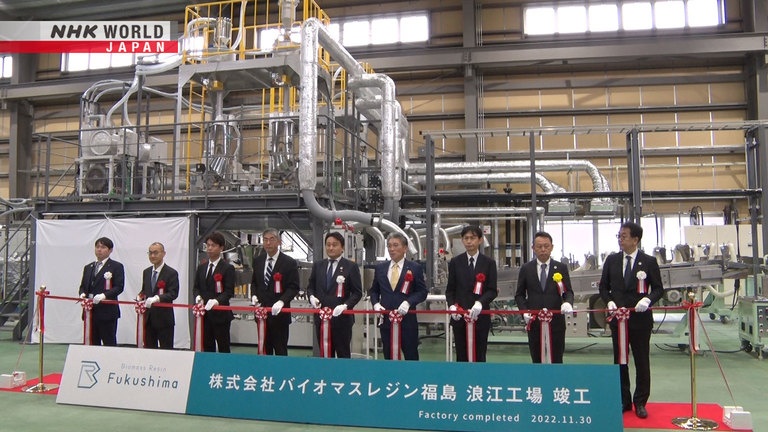Transforming Surplus Rice into Bioplastic: Manufacturing Innovator - Kamiya Kazuhito
In Japan, rice consumption is falling, over 420,000 hectares of farmland lies unused, and a great volume of rice goes to waste. Kamiya Kazuhito has spent 15 years developing a company that uses it to make biomass resin—a form of plastic. In response to rising demand, Kamiya took advantage of unused farmland in Fukushima Prefecture, and began large-scale production. This created jobs, contributing to the recovery of an area devastated by the 2011 Great Earthquake and Tsunami.




Transcript
"RISING"
May 2022, Osaka.
This is Japan's biggest exhibition
featuring green and recycling technology.
One booth is drawing a lot of attention.
Smart phone cases.
Bento boxes.
Toys for babies and toddlers.
There's a whole array of products.
All of them are made from rice.
Grains that are usually discarded as old
or not suitable for retail have been repurposed.
The rice is mixed with polypropylene
to make this biomass-based plastic.
By doing this, the use of petroleum-based plastic
can be reduced by up to 70%.
The current interest in minimizing plastic use
has put this new material in the spotlight.
During the pandemic, I noticed how much plastic packaging we were using.
It generates so much waste.
I am very interested in this kind of eco-friendly product.
Rice is so familiar to Japanese people.
It's reassuring to know that that's what they're using.
It creates a softer image.
Kamiya Kazuhito has been involved
in the development of rice-based bioplastic for 20 years.
It took many years of trial and error
to create a commercially viable product.
I'm genuinely moved that we have now made all kinds of everyday products
from our rice-based bioplastic.
It's a big moment.
Kamiya's current focus is helping the Namie area of Fukushima
recover from the 2011 nuclear disaster.
Namie was the site of much rice production.
But today, many of its fields lie deserted and unused.
Kamiya plans to set up a bioplastic production base in the town
and boost the area's rice farmers.
Turning abandoned fields back into rice paddies is an important step.
It has been a very hard, very difficult decade.
I hope the next ten years will shine more light on this area.
One way to move forward is by trying new ideas.
I'd like to take up the challenge myself.
Discover how rice-based bioplastic
is bringing agriculture back to a disaster-hit region.
"Transforming Surplus Rice into Bioplastic"
Manufacturing Innovator - Kamiya Kazuhito
A lot of rice is grown in Minami-Uonuma in Niigata Prefecture.
Located here is a hub for rice bioplastic production.
This is the kind of rice that we use.
Most of it is old, or it doesn't have good flavor.
Condition-wise, it is edible, but not suitable for sales.
The raw material is old, crushed or surplus rice
collected from the local area.
When compared to normal rice, the color and shape are irregular.
(Left:Nomal rice Right:Unsellable rice)
The factory buys rice that would be thrown out by farmers or wholesalers.
It turns the grains into bioplastic.
This mechanism adds heat, water and pressure to the materials.
All those different elements are turned into a single product inside.
This bioplastic is made by mixing polypropylene and rice, then heating it.
The ratio of rice varies from 30 to 70%
depending on the plastic's intended use.
It's as strong and easy to shape as regular plastic.
Japan first began researching rice bioplastics around 20 years ago.
It took place at the University of Kyoto.
We visited a research team in the Faculty of Agriculture.
Associate Professor Yoshioka Mariko
researches how to make plastic materials from plants.
She was a member of the team that first researched rice bioplastics
back in 2003.
The agricultural ministry came to us.
"Can you find an industrial use for inedible rice?"
For example, they wanted to make use of crushed grains
that were discarded during polishing and refining rice.
The research was funded by the government
as a way to make more efficient use of rice grains.
But rice and plastic didn't mix.
Rice is hydrophilic. It loves water.
Polypropylene is a synthetic polymer that behaves like oil.
Those two substances famously don't mix.
But we added a compound that reacted with the hydroxy group of rice starch.
That made the result extremely strong.
I think that discovery has helped produce the products we see today.
Kamiya spotted the potential of rice-based plastics.
20 years ago, I got the feeling that people were starting to talk about the environment
and climate change.
It really seemed like the perfect timing to look at bioplastics.
The first rice-derived bioplastic products emerged in 2005.
They went on to become part of the movement to minimize plastic use.
Chopsticks and spoons,
cups and other tableware.
Today the bioplastics are even used in everyday trash bags.
These baby toys are popular with families and daycare centers.
People like that it makes use of domestic rice.
Because they're made of rice,
we feel relaxed about the children putting them in their mouths.
It's reassuring and makes us happier to play with the toys too.
They are more than just substitutes for plastic products.
The properties of rice means there are broader applications.
In 2011, a massive earthquake and tsunami devastated northeast Japan.
It also caused the Fukushima Daiichi nuclear disaster
which caused shockwaves around the world.
This footage is from 2016.
The disaster meant the agricultural land in Namie
and the area near the power plant had to be evacuated.
In order to restore it, contaminated soil was packed and removed.
Kamiya first visited Namie in December 2020,
the year decontamination work ended.
After nine years, agricultural use could once again be scheduled.
There was nothing here at all.
The rice paddies make a difference, I think.
There's still a lot of work to do.
One step at a time.
In 2021, farmer Abe Jinichi returned to Namie.
The test for radioactive cesium came back fine.
It's under 100 becquerels.
Rice has been grown as an experiment in Namie since 2014.
This proved the soil was safe.
But bringing back the high-quality rice from before
in fields abandoned for over a decade will be tough.
Many farmers have given up altogether.
(Did you want to return?)
I've always loved farming.
I've been a farmer for 45 years.
And this is where I was born.
Before the disaster, Namie had over 1,000 farming households.
Official counts say there are just 17 now.
Those who have returned to the area have to start from scratch
to revive the rice paddies.
After a decade,
most people have built new lives in the places they moved to.
Few will want to return now.
There's nothing we can do to change the past.
We just have to be optimistic and move on.
We can't bring back the past after all.
In May 2022, rice planting begins in a corner of Namie.
Saito Mikiko is in charge of rice farming efforts
by Kamiya's firm in Fukushima.
A former environmental consultant,
she moved to the firm in April 2022.
She's working to set up a new business that will help devastated areas.
I came to Namie immediately after the disaster.
I'm not sure that much has changed.
I was honestly shocked at how little had been done to rebuild.
I hope we can help change that by starting a new industry here.
Saito's team rents fallow fields from farmers who've left the area.
They'll grow rice to use in bioplastics
and hope to revitalize Namie's farming traditions.
The factory will be here.
Construction has begun on the new factory.
Once complete, Namie will have a new industry,
one which uses locally grown rice.
I look forward to the autumn.
The rice harvest and a completed factory.
I can't wait.
Saito's next stop is the rice paddies of farmer Abe.
He began growing rice again in 2021,
but most of his crop was used for animal feed.
He spoke to ten members of his co-op,
and they've decided to help grow rice to make bioplastic.
Good to see you!
The biomass firm have explained their business.
They hope that it will help reduce plastic use in society.
I think there is a lot of potential there.
I think that I'd like to work with them.
Meanwhile, the firm is also recruiting staff for the factory.
We visited one such person.
Okada Toshimitsu used to work at a local factory
manufacturing machine parts.
He lost his job of 20 years after the nuclear disaster.
The Self Defense Force came and asked us to evacuate.
They said radiation can't be seen or smelt,
and its effects aren't fully understood.
So we ran to Fukushima City.
Okada returned to the area two months later and got a new job.
I measured the radiation levels.
It was grasping at straws, perhaps.
I had to feed my family after all.
That definitely tipped the scales.
Okada has been measuring radiation
for nearly ten years to raise his two children.
When he heard a new factory will open in Namie,
he decided to try and return to manufacturing work.
I had never heard of mixing rice and plastic
to make new plastic.
But I wanted to take up a new challenge.
Early September, Minami-Uonuma in Niigata Prefecture.
Staff training is underway in preparation for starting up the Namie factory.
The resin emerges at the front.
Check carefully for any black spots or anything out of place.
Then start production.
The team spends two weeks learning the manufacturing process.
Okada is among them.
It's his first time in manufacturing in ten years.
Ah, it's quite tricky.
If you leave it crooked, it can cause clogs in the machine.
Got it.
I've just started,
and at a disadvantage.
So I want to work with the rest of the team to relieve any issues
and I have fun with the work.
Every member of the Namie factory staff is from the local area.
The youngest is 22-year-old Hatakeyama Satoshi.
He was still in primary school when the disaster happened.
We evacuated, then went to Yamagata.
So I was born in Namie and raised in Yamagata.
I was previously a daycare worker.
All of this is new to me
so it's a lot to take in.
Everything is difficult just now.
His family are returning to the area after a decade away,
so Hatakeyama found local work to stay with them.
It's his first time even seeing industrial machinery.
- Always lower the rotations first.
- Understood.
I think the factory will bring other young people to the area,
which is great.
I'm really looking forward to it all.
Hatakeyama returned to Namie in 2021.
His family were local strawberry farmers.
The day of the disaster hit during the peak of the harvest.
I said I'd stay to look after the greenhouses.
It was a mandatory evacuation.
We came back after a decade away
but it's not recoverable.
Such a shame.
They started growing "egoma," a leaf which grows even in poor conditions,
but it will take much longer for the farmland to recover.
In the normal course of events,
I would have finished fifth grade here and grown up here.
I had lots of friends.
Then I suddenly ended up in a strange area.
I've no good memories of that nuclear plant.
For Hatakeyama,
manufacturing bioplastic from locally grown rice is a new ray of hope.
I want to stay close to my family.
It's a new factory for the company
and I got to be one of the founding members.
I may not be able to do much,
but I look forward to helping the company grow here.
I'll do what I can.
October. Time to harvest rice in Fukushima.
Kamiya's staff and the local farmers helping them have produced
around 50 tons of rice this year.
All of it will be used to make bioplastic in the Namie factory.
It will begin operations in a month.
November.
The vacant lot of the spring is now home to a brand-new factory.
Kamiya comes for a final check of the factory before it opens.
There wasn't much going on here,
and now we've built a whole factory.
I hope the residents feel that this will help bring them closer to a recovery.
Once operations are fully underway,
the factory will be the firm's largest,
able to produce 3,000 tons of bioplastic a year.
The five local staff all have their own thoughts about the opening.
Everyone's so great.
Really?
I hope the rice-derived toys take off with little kids and their families.
We've finally made it to the starting line.
There's a lot to be optimistic about.
I hope we can all have fun here.
Yes,
so much better to enjoy an eight-hour shift with smiles
than spend it with a frown.
There are people who are cheering us on who are happy for us.
I hope you all will take this as an opportunity
to enjoy your work and try new things.
November 30th.
Many people have gathered for a ceremony to mark the factory's completion.
The Namie factory is now officially open!
The machinery is turned on.
Rice-based bioplastic manufacture has begun in Namie,
and there's a lot riding on it.
Late December.
Farmer Abe has come to visit the Namie factory.
Local farmers' rice is used for livestock feed,
but the factory buys at higher prices.
This year, Abe and ten farmers in his co-op provided about 40 tons of rice.
The completion of the factory is a major change
for Abe and his fellow rice farmers.
This is freshly made.
If you smell it,
there's a faint trace of rice, I think.
I'd never dreamed you could make this from rice.
Growing rice sure isn't getting any easier.
But
after 11 years away,
I really do want to keep going.
At first, I was curious about what kind of factory they were going to build.
Now I'm seeing the whole thing in action,
I feel a lot more secure about the future of my crops.
A month into operations, Hatakeyama is getting used to the work.
The results are different every day.
Sometimes good, sometimes bad.
Every day I try to make it as good as possible.
That's what makes my work worthwhile and fun.
Okada spent a decade experiencing the aftereffects of the disaster.
Now he's working toward a new goal for the region.
We're all working together to improve our skills.
We want to make sure all of us can produce an identical product.
We have a great team.
I want to work hard
and help build up the local area
and to contribute to society at large.
Imagine all these were rice paddies.
A lot of people have painful memories of this area.
Our own staff have been through difficult circumstances.
But we are all looking to the future.
We want our work to draw more people to this region,
to attract more people to join us.
It inspires me to keep working hard.
Kamiya and local residents are tackling a new challenge for the future.